 Lucky bamboo is famous for its curls. But what many people don't know is that those curls are not natural, Yes you have to put in some effort to make them go into spiral direction because its almost impossible to get them curly without proper guidance. There are two things that makes lucky bamboo turn toward a required direction - light and gravity(earth's pulling force). Because of the rigid and straight stalks of the bamboo its little difficult to use gravity, so you can follow any of the three techniques I am describing below which uses light source to get those curls.
Lucky bamboo is famous for its curls. But what many people don't know is that those curls are not natural, Yes you have to put in some effort to make them go into spiral direction because its almost impossible to get them curly without proper guidance. There are two things that makes lucky bamboo turn toward a required direction - light and gravity(earth's pulling force). Because of the rigid and straight stalks of the bamboo its little difficult to use gravity, so you can follow any of the three techniques I am describing below which uses light source to get those curls.Starting with most advanced which requires more care and effort to basic technique for beginners.
Bucket Technique.This a typical method used by most professional lucky bamboo growers and is good if you have many sticks.
- Take a small bucket, put some water and keep your lucky bamboo in it.
- Now make a slant depression in the ground big enough to hold the bucket in one place at a tilted angle, around 40-45 degrees. (see! Its lot of work)
- Make sure the source of light is right about the bucket, or just keep it outside in a shade.
- Now just sit back and relax, and keep turning the bucket slightly once every week(its just like making champagne).
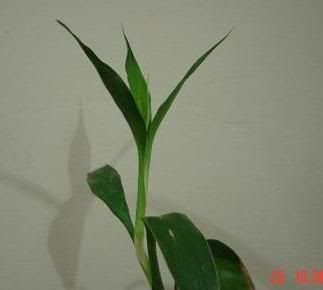
Box Technique. Most of you can do this with little effort. All you need is some cardboard and luck bamboo :-)
- Keep your lucky bamboo is vase so that the sticks are stacked straight.
- Make a cardboard box big enough to hold whole vase and sticks inside it.
- Make a small hole (few inches diameter) on any one side of the box near the top.
- Keep the vase with lucky bamboo in it and place this box where light can enter only from the hole.
- Turn the box slightly every week.
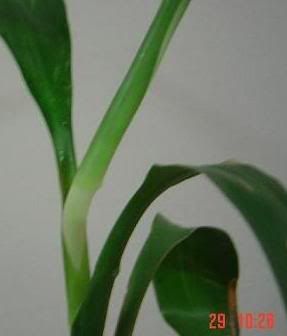
Window Technique. This is for really lazy people or who don't care much about the symmetry of the curls. Like the name suggests just keep the vase near window and turn it once every week. Just make sure that your plant is NOT receiving direct sunlight because that can cause it to turn yellow and die. You can read my earlier posts 5 Tips to take care of your Lucky Bamboo and 10 symptoms that can tell you that your lucky bamboo needs your help! for other caring tips.
Just one final advice to all my gardener friends. Lucky bamboo grows very slowly, only couple of inches every year. So just relax and wait for some time before you see any results.
 Welcome to part 2 of Planting Herbs for summer series.
Welcome to part 2 of Planting Herbs for summer series.The reason that lavender is so famous among gardeners is because of its aromatic and edible flowers. Lavender flowers can be eaten in salads or can be added to soups, or you can use it for seasoning or you can brew it into tea. Lavender can even be added to perfume (some believe it have aphrodisiac qualities). Its dry flowers gives fragrance for long period of time. Essence made from lavender flowers is very popular among rich and famous. With such a huge list of qualities no wonder Lavender makes to the cover of so many home garden magazines.
Plant selection.
You can grow lavender from seed but only very few species would come true. There are many varieties of lavender plants available in the market. While Spanish lavender is known for its beautiful dark purple flowers, Hidcote and Munstead are two varieties famous for their hardy nature and are best suited for cold climates. Provence is famous for its sweet fragrance and Grosso for its camphor like smell and tapered flower head. Choose the variety that's most suitable for your climate. Your local nursery can help in this.
Site selection.
- Choose a well drained ground which receives at least 5-6 hours of sunlight daily.
- Soil should be well mulched and free from any kind of weeds.
- When planting in a pot make sure the soil does not hold water, rot root is one of the common problems in lavender plants.
- Use a loose, soil-less mix for planting, put some gravel on the bottom.
Planting.
- Take the plants and set them 12 inches apart in a well drained soil.
- Make sure there is plenty of open space for the plant to get enough sunlight and air.
- Mulch the area around the plant but leave one inch of gap around the plant.
- Water thoroughly.
Care.
- Keep the soil on the dry side as rot rotting a known problem with the plant.
- Water the plants when the top of the soil appears dry.
- No need to give fertilizer to ground lavenders.
- Protect the plants from harsh winter. Planting them next to stones and bricks gives them extra heat during the winter.
Pruning.
- Plants extends the life of the lavender and should be done just after the bloom.
- Cut about one-third of the plant but leave some leaves on.
Tip on Cut flowers.
- Lavender makes best cut flowers when the cut is taken as soon as the bud starts opening.
- Hang the plants upside down on a rope and let them dry.
Some facts about lavender
- Latin Name: Lavendula angustifolia
- Family: Labiatae
- Common name: English Lavender
- Climate range: Temperate, Cool
- Aspect range: Full sun, Half sun
- Full height: 2-3 feet
- Flowering Season: Summer
Planting Herbs for summer - part 1: Mint
Planting Herbs for summer - part 3: Basil
other series:
Growing beautiful plants this summer from bulbs
If they are given suitable condition they can easily take over your garden. So my advice is to either plant the mint in a pot or in a container bound in your garden.
Best time of the year to plant the mint is early spring and can be harvested for 6-8 months when planted outside. You can buy small mint plants from your local nursery as soon as the danger of frost is over and the ground can be worked.
The plant can grow 2 to 3 feet in 3 months time and will produce violet blooms in mid- to late summer. The leaves have very strong fragrance and can be used for garnishing salads, meat, beverages etc.
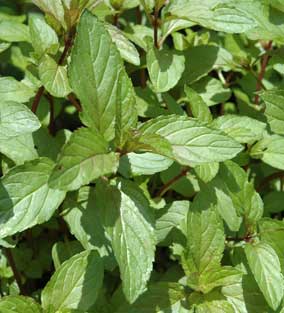 Site selection.
Site selection.Mint like partial shade to full sunny location. Choose a location so as it can grow freely without disturbing other plants as it can easily kill them. Soil should be well-dug, moist, fertile and water-retentive, but not water-logged.
Planting.
For planting in pots, use a clay or plastic pots atleast 10-12 inches in diameter and fill with compost-enriched potting soil.
For ground, plant different varieties of mint in different location to avoid cross pollination. Make sure the soil is moist. Buy only couple of plants of each variety as they will spread easily.
Place each plant about 1 to 1.5 feet apart and water them thoroughly.
Water the plant regularly for 2 more weeks.
Care. Rust is the only problem seen in mints. Check the plants periodically to see any sign of disease and remove the plant if rusting occurs. Chemical spray should be avoided to keep the plant suitable for consumption.
Pinching the top of the plant will cause more leaves and branches to grown and make your plant bushier.
It was love at first sight. First time I lay my eyes on it I was mesmerized by its beauty. Fresh green leaves on its thick dead stem had this out-of-the-world feeling. It was a symbol of perfect harmony between old and new. Lucky Log is here to stay!!
You might have seen small green bamboo in gift shops, stores and god knows what places. They are called lucky bamboo and suppose to bring good luck. But now a new star is in town. Lucky Log.

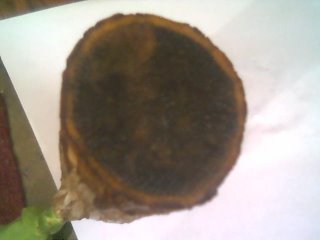 Look, no roots!!!
Look, no roots!!!updated!! (on katypine's guidelines)
Some useful facts about lucky log:
- Scientific name : Dracaena fragrans 'Massangeana'
- Common name: Corn Plant
- Origin: Zambia, West Africa
- Sun exposure: 50% shade, filtered light
- Water: little to Moderate watering
- Propagation: Stem cutting and through suckers
The plant can grow to a height of 20 feet when planted in ground. Pot bound plant's height can be controlled. The leaves can grow from 1 to 3 feet long and according to NASA's finding the plant can act as very good air purifier for house.
Even though Lucky Bamboo and Lucky log (or corn plant) both belongs to Dracaena Family, lucky log produces fragant white flowers in late spring.
ps: Apologies for the image quality, just quicksnaps with my dad's nokia 6255 mobile camera
Calla lilies (Genus Zantedeschia, Arum lilies or Easter lily) are large tropical trumpet shaped flowers with graceful light green stems. They come in pinks, yellows, whites and greens.
Calla lilies or 'magnificent beauty’ makes beautiful cut flowers and can last for several days.
It was one of my closest friends who introduced me to this lovely flower. She gifted me with a painting of calla lilies. Then few months later I came across some bulbs displayed for sell at my local nursery. There I saw a poster of Calla lily and immediately I bought 3 bulbs for 20 cents per piece (now THAT’S dirt cheap).
While picking healthy bulbs I did the normal checks as I did while buying other bulbs.
Planting
- Callas requires lot of water but it doesn't like wet feet. I planted my bulbs in a 12 inch clay pot and filled with some good quality soil.
- While choosing the location keep in mind that calla likes 4-5 hours of direct sunlight.
- For me it’s easy. Just move the pots to a suitable place.
- Make sure you keep the soil damp. Choose Peat moss, compost or decomposed manure as per availability.
- Remember to plant the bulbs with visible eyes on the top.
- Cover with 3-4 inches of soil.
- Water Calla bulbs, soaking the soil.
Care
- Keep the soil damp all the time.
- Provide at least 4-5 hours of sunlight daily.
- In summer they need extensive watering and some fertilizing.
- Cut off old flowers and leaves to keep the plant healthy.

older posts in this series
How to choose Plants for summers from bulbs part 1 – Crinum
How to choose Plants for summers part 2 – Caladium
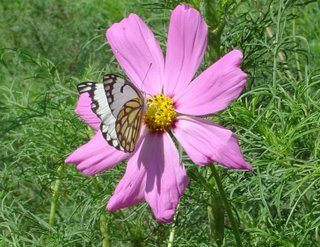

Have a look at some of the beautiful pictures I took couple of days back.The flower was shaking with the wind and it was really hard to focus my camera.
I am very happy that the pictures came out really nice.
I used my sony cybershot with autofocus and macro and took the picture around 10 in the morning. I am very happy that the pictures came out so nice.
Cosmo is a beautiful plant that comes in 3 colors - white, pink and maroon. You can plant them in late winters and can get flowers in early months of the year. They are propagated by seeds.
“Cannas are not for the faint-hearted! But it is for these flamboyant characteristics that the hot-headed among the gardening fraternity will choose them.” – Ian Cooke

Cannas or Canna lilies are lush tropical plants with leaves that fall into the "large" to "huge" range with vibrant blossoms on tall stalks. Foliage may be green, bronze, gold, or mulitcolored, and the tropical look is further enhanced by flowers in apricot, pink, gold, red, orange, and white. Plant can reach anywhere from 3 to 10 feet depending on the variety.
Planting:
- Cannas can be planted in the spring. But after the danger of frost is over and soil is warm. Find a location where the soil drains well. Prepare soil to a depth of 12–13 inches and mix in 5 inch layer of peat moss, compost or decomposed manure.
- Cannas needs atleast 5 hours of direct sunlight. So choose the site which gets full sunlight.
- Plant the rhizomes flat an a hole of depth 5–6 inches. Press it well.Make sure the eyes are pointing up, if visible. Cannas Don’t have a top or bottom parts so don’t worry if you can’t see any eyes.
- Cover it with 3–4 inches of soil and water it thoroughly.
Care:
- Apart from weekly watering and 4–6 hours of direct sunlight cannas need very little care. General purpose fertilizer works well for this plant.
- Dead head old blooms to give plant a better look. Seed pods forms easily if the old blooms are left on the stalk.
- Cannas is very hardy plant. As a matter of fact there is a risk of cannas taking over the rest of the garden. So keep a watch and dig out the rhizomes when they start growing in excess. I still remember when I was a kid I spent one weekend with my younger siblings pulling out the plants and playing javelin throw.
No doubt they are so popular among home gardeners and professional landscapers because of their beautify flowers, green leaves and extended flowering period.
older posts in this series
How to choose Plants for summers from bulbs part 1 – Crinum
How to choose Plants for summers part 2 – Caladium
Caladium is famous for its big and colorful leaves. You can get caladium in red, yellow, white and many shades of these color . Big leaves keeps the room fresh and cool throughout summer.
Caladium from Tubers.
Propagation of caladium occurs through tuber. When the tubers arrive unpack them immediately and spread them on a piece of paper or towel. Caladium bulbs contains moisture and will rot if not taken out rightaway. Bigger the tuber, more will be the number of leaves. Tubers can be as big as 6 inches in length.
Scooping of tubers.
A normal healthy tuber gives one or two big and strong leaves. But if more number of leaves from a single tuber is desired then scooping or de-eyeing can be done. Scooping is a very simple method of increasing number of leaves and making the plant bushier. When the tuber arrives, it would contain some visible and many invisible auxiliary buds or eyes. With a sharp knife tip scoope out the main bud. Take care not to harm the nearby auxiliary buds, and don't make deep scoope which might lead to rotting.
 Planting
PlantingCaladiums can be planted in ground or in pots. To get a beautiful arrangement plant one big tuber or 2-3 small tubers. Use a light mixture of peatmoss, soil and sand. Plant the medium sized tubers 2 to 4 inches apart. Since the roots of caladium comes from the top as well, cover the tubers in 1-1.5 inch soil. water it thoroughly.
Caring tips:
- Being a tropical plant, caladium needs lots of water and good dose of plant food. Other than that this plant needs very less care.
- Keep the soil moist all the time untill the sprout occurs.
- Don't let the plant wilt or it may loose leaves and go dormant.
older posts in this series
Plants for summers part 1 - Crinum.
preparations you must make well before collecting seeds:
- If you plan to collect seeds then obviously you should leave some flowers on the plant. So don't dead-head every single peace because you CAN'T collect seeds from dead flowers.
- Buy some paper envelops to store seeds. I make my own with old newspapers. Paper envelops are best because they allow moisture to escape and lets seeds have some air.
- Keep a pen or pencil handy to label the envelops as you collect seeds so that you don't mix your white cosmos with pink ones.
- Use small stick or scissors to take out seeds.
- Remember you won't get the same plant from these seeds if open pollination has occurred. So be readily to be surprised.
- Let the seed pods mature and dry out on the plant before collecting. The color will change from green to brown. Seeds collected from green seed pods won't germinate.
- If you are worried about loosing your seed then cut the flower and put it in a paper bag and let it dry.
Bagging:This method is particularly useful for seeds that are really small. Or you don't like seeds sticking in your nail. Just cut the whole seed pod and put into a paper bag. Crush the seed pod gently and take out the husk and remains of seed pod out. Seal the bag with some glue.
Direct collecting: This is the most common method of collecting the seeds which are big enough to handle with hands. Just separate the seeds from seed pods on a big piece of paper or plate (preferable white in color if the seeds are relatively small). Now transfer the seeds to the bags and seal the bag.
These are just few tips and methods of collecting seeds. With time and patience you can achieve some good results.
Crinum
Summer is here! Cold but romantic nights are gone. And so are most of cosmos, pansies, voila and dahlia. To bring the colors back in my garden I must do something.
On my last visit to my local plant nursery (which is like -twice a week) I noticed some new arrivals, they were called bulbs. I bought 3 of them, one of which was already having a pair of leaves while other two were still dormant.
Choosing the right bulbs is the only difficult task in growing Crinum.
To have flowers all summers choose bulbs which are at different stages of growth.
Check for symptoms of rotting by pressing the bulb slightly. A good piece would be hard.
Also check for any cuts as that can cause rotting once the bulb is planted.
Dry and dull bulbs would have less chances of growing successfully and even if they grow, the plant won't be very health.
Crinum likes to be crowded. So I planted all three in one 12 inch clay pot. The bulbs should be covered with 2-3 inches of soil.
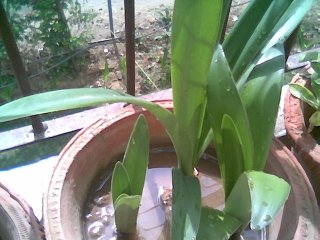
Crinum needs atleast 6 hours of sunlight daily. So its safe to plant them outside.
Water them regulary and nicely, but not before the soil surface dries out. Check by pressing your finger in the soil before watering as excess watering can rot the bulbs.
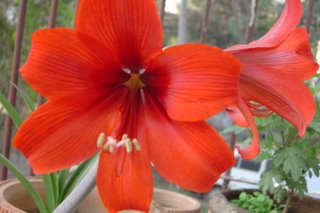 In one month's time Crinum gives big red flowers that can be used as cut flowers.
In one month's time Crinum gives big red flowers that can be used as cut flowers.With little work you can have beautiful Crinum in your gardens this summers and next summer and summers after that too -with only one set of bulbs!
other posts in this series:
How to choose Plants for summers part 2 – Caladium
How to choose Plants for summers: part 3 - Canna Lilies
How to choose Plants for summers: part 4 - Calla Lilies
Lucky bamboo disease and its cure
I never get tired of saying that "lucky bamboo is very hardly plant" :-), and if you just leave it alone it would grow happily. But there are times when it needs some extra care and attention.
Symptoms of lucky bamboo disease
Here are some early signs of lucky bamboo disease and their simple cure:
Yellow leaves
Complete leaves turning yellow and falling down one by one.(more...)
Brown leaf tips
Drying out of leaf-tips is by far the most common problem(more...)
Dull brown Stalks
Lucky Bamboo stalks are turning soft(more...)
Dull, rustly roots
Healthy roots of water based plant are cream or yellow in color and that of soil potted is orange(more...)
Lower part of stalk turning yellow.
If the upper portion is healthy green but lower part is yellow
Insects infection.
Lucky bamboo is very resistant to insects.
Algae in water.
You can ignore it if you want.
Broken Stalk.
If you broke your lucky bamboo stalk by accident
Slow plant growth.
Lucky Bamboo have very slow growth.
No curls on the plant.
This is again not a problem with the plant.
So if you have a lucky bamboo then just chant this mantra "leave it alone" leave it alone" and you will have a healthy plant for years.
posted in Lucky Bamboo category.
Just follow the simple instruction given here and in no time you will have your own lucky bamboo - for free! AND it will give you great satisfaction of creating something new out of nothing. We are going to propagate lucky bamboo by stem cutting. Though some people would suggest not to take the cutting of the plant, from my experience I can assure you that its completely safe.
shall we start then:
- Take a sharp knife. Clean it with soap or alcohol to prevent any infection to the plant.
- Now take the bamboo stalk out of the pot and place it on a hard flat surface.
- Make a clean cut just about the node(joint). No need to make a slanted cut as you would have done in case of a normal cutting, root will come from all the side uniformly.
- Dip the cutting in a rooting harmone solution for better results. I never use rooting solution in case of lucky bamboo and still they root without any problem. Its depends on your choice.
- Take the cutting and place it in the pot with the rest of the lucky bamboos.
Now just leave them alone and take care in normal fashion. Cutting will root in about two month's time.
Spray water daily to the cut part of the mother plant to accelerate the regeneration of new branch.
Though I have never seen rotting of cutting but its safer to check the cutting once a week for any rare case of rotting. If cutting rots, remove it from the arrangement.
Great job. In no time you have brought your lucky bamboo arrangement to a size suitable for the pot and as a bonus you have some new lucky bamboo that you can gift to your friends on next christhmas.
- 2 stalks means Love.
- choose 3 stalks or 6 stalks to attracts happiness.
- Have 5 stalks or 7 stalks for good health.
- 8 stalks gives growth and wealth.
- For generally good fortune have 9 stalks.
- Arrangement of 10 stalks brings in perfection.
- And 21 stalks gives powerful blessings.
- Light. filtered sunlight or artificial light is best for lucky bamboo. Keep it away from direct sunlight.
- Water. keep the bamboos in 2-3 inch of water only. change the water weekly to prevent fungus.
- Fertilizer. Keep fertilizer to minimum. Strong fertilizers can burn the roots so dilute the solution you usually use for plants to one-tenth its strength.
- Soil. Usually lucky bamboo is kept in water, it can be planted in soil too. Since it needs lots of water, one should water it regularly. But let the soil surface dry before watering to prevent root rot.
- Temperature. Lucky bamboo is very hardy and can tolerate extreme temeratures(41 to 95 F) but try to keep it between 60 to 70 F only.
Lucky bamboo needs very little care. Place it in any place you like - bathrooms, halls, offices or study room.

Lucky Bamboo disease and planting resource page
What is lucky bamboo ?
Lucky bamboo is probably the most famous indoor plant. You can find it in gift shops all over the world. This plant is known for its beautiful curly stalks and is recommended by Feng Shui masters and practitioners for improving Feng Shui and creating positive Chi around your home and work place.Lucky bamboo arrangements come in different number of stalks and each number have a different meaning attached to it. Lucky bamboo thrives well in filtered sunlight which makes it suitable for offices. It is pest resistant and requires very little attention on your part. Just change the water on weekly basis and it won't bother you. Lucky bamboo doesn't even need fertilisers.
Lucky Bamboo numbers explained
A very good explanation of what different number of stalks means so that you can choose the right one for yourself.How to pick lucky bamboo for better luck!
Curls of Lucky Bamboo stalks
This tutorial covers three methods suitable for all the levels of gardeners and plant lovers that teaches how to get those curly stalks.How to make lucky bamboo curly - tutorial for all
Caring tips
Some simple and effective tips to take care of your Lucky bamboo.Tips to take care of your Lucky Bamboo
Lucky bamboo disease symptoms
Explaining poor health symptoms and lucky bamboo disease in details.
10 symtoms that can tell you that your lucky bamboo needs your help!
Propagation method for Lucky Bamboo
In 5 easy steps propagate your Lucky Bamboo! And get new plantsSome Boring facts about Lucky Bamboo
- . A little known fact about lucky bamboo is that its not really a bamboo but it actually belongs to lily family.
- . Lucky Bamboo's scientific name is Dracaena sanderiana but it is known as Ribbon Dracaena or sometimes Ribbon Plant.
- . Beautiful curly stems of lucky bamboo doesn't form on their on.
Lucky Bamboo
Plants having something different and unique character in their shapes, size or even application attracts my attention at any place. My eyes are always looking for something green..something extra-ordinary. so when my friend asked me to help him find some nice plants I agreed almost immediately. We went to Dilli Haat -kaleidoscope of handicrafts from different parts of country. They have opened a new nersery section.There I saw these really beautiful, long green sticks climbing up in the air like a snake in a spiral shape with couple of long leaves at top. My heart told me I must have it. On enquiring I found out that they were "Lucky Bamboo" - an indoor plant that looks like a bamboo but not actually a bamboo.
The owner told me that these are imported plants and though he is selling them for the first time they are moving out like hot cakes. May be that's the reason behind such a high prize. While I can buy any common plant in here for half a dollar, this lucky bamboo was being sold for 3 dollars a piece. And to top that these sticks had no visible roots. But the owner assured me that it will root in one month's time. But I like it soo much that I ended up buying one pair.We had dinner and came back home.
If you are wondering what happened to my friend- well he baught some beautiful pancies.
Gardening
Hello to my old friends and welcome to new ones.
Finally I have moved my blog to blogger.com. I am very excited about its new features.
Talking about excitments, there is one more thing that excites me alot, gardening! It might sound strange to some but plants are my passion. I can spend hours and hours working my garden or browsing plant nurseries. And the best part about this hobby is that it's very cheap to maintain and it never fails to impress ;-) (hey who won't stop to have a look at beautiful roses and daisies).
From my childhood only I am fasinated by all the different colored flowers and vegetable. I spent early years of my childhood in a village, yes a proper village with our own farms, cattles, dog and tractors. Now I am a final year computer science student studying in a concrete jungle.
No doubt I miss my childhood alot.
This blog is my way of sharing my years of experience. Here I would post articles about all sorts of new and old plants I am experimenting with.
freshLife
